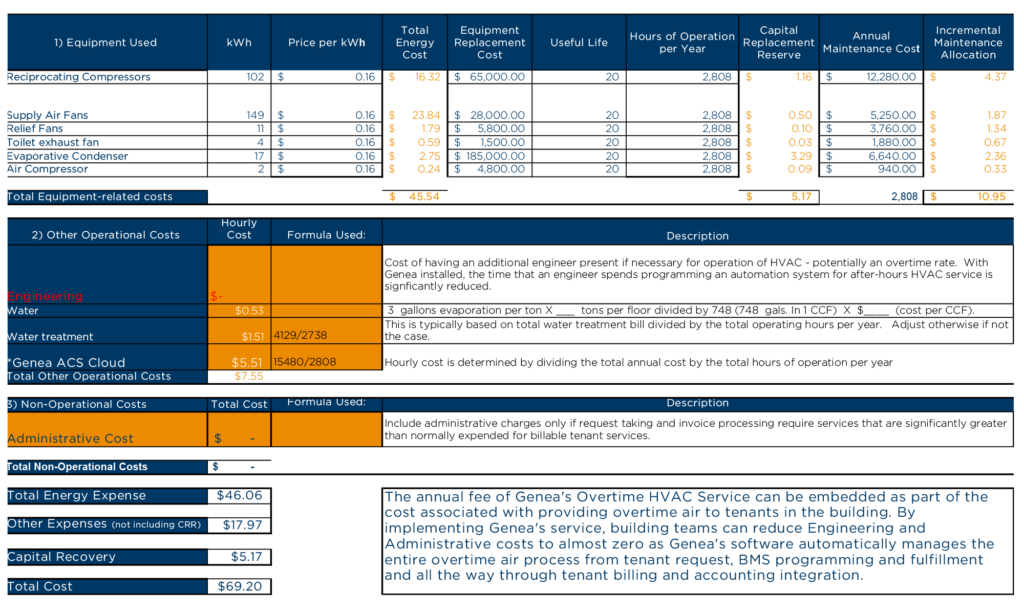One of the biggest concerns for property teams assessing new technology is determining how to fit it in the budget. Budgets are always tight and getting budget approved for something new and not-mission-critical can be an uphill battle.
As a result, property teams are always looking for ways to implement new technology without impacting the operating budget. Overtime HVAC automation offers a unique opportunity to pass through the cost to tenants while ensuring that only tenants who choose to benefit from the service bear its cost. This creates an ideal chance to benefit from technology without risking precious budget dollars.
Today, I’d like to walk you through the best practice many of our customers use to build the cost of our software into their after hours HVAC hourly rate. Here are a few primary benefits to doing this:
- The software cost no longer impacts your operating budget.
- Only the tenants who use the software bear the cost (in direct proportion to their usage).
- You have the opportunity to more than cover the software cost, since the convenience it provides tends to increase overtime HVAC usage.
What is Overtime HVAC Software?
Before we get into how to pass the cost of overtime HVAC software through to your tenants, let’s establish what exactly it is. Overtime HVAC software provides an app and/or web interface that lets individual tenant users make after hours HVAC requests directly. When a request is submitted, the software automatically fulfills it and generates the tenant’s invoice (based on their individual lease). The software fully automates an otherwise fragmented and manual process that property team members must typically undertake every time a request is made.
How Are Overtime HVAC Rates Calculated?
Each year, property teams determine the appropriate hourly rate to charge their tenants for overtime HVAC usage. This rate calculation takes a variety of expenses into consideration, which generally include:
- Energy costs: How much the delivery of an hour of overtime HVAC will contribute to the building’s energy bills.
- Equipment depreciation: The longer and more often a building runs, the harder the equipment works. Using the equipment outside of leasing hours necessitates considering and covering the cost of its eventual repair and/or replacement.
- Engineering costs: Without automation software, fulfilling requests requires manual involvement from the property team. This line item considers the hourly costs of engineering resources and the average time spent programming an after hours request.
- Administrative costs: This line item estimates the cost of property administrators or accountants managing and calculating the appropriate bill for each request. It combines the hourly cost of administrative resources with the average time spent on request-related tasks.
Once these costs are totaled and some buffer or profit is added, the resulting rate is compared against other market rates (these can vary based on geography). Once all has been considered, a building’s rate for the coming year is established.
Passing Through the Cost of Overtime HVAC
This calculation process presents an opportunity to easily build the cost of overtime HVAC software into your hourly rate. You can determine a per-request-hour cost (usually just a few dollars) by taking the cost of the software and dividing it by the expected number of hours of overtime air you fulfill.
You can either add the number to your existing overtime HVAC costs or use it to replace your current engineering and administrative cost line items, since the automation of overtime HVAC request fulfillment and billing should clear your team’s plate entirely of related tasks. Both are easy ways to pass the software cost through to your tenants and eliminate the need for a line item in your annual budget.
Click on the image below to see an example of a costing spreadsheet, complete with the inclusion of the Genea software cost and the zeroing out of the engineering and administrative costs.
This approach helps make an easy case for implementing software to manage your overtime HVAC program (though there are other value drivers as well). Not only can you pass the cost directly through to the specific tenants who benefit from the technology, you can potentially more than pay for the investment, since the software’s convenience frequently drives additional usage.
Interested in determining whether this is a fit for your building? Schedule a demo and we’ll walk through the specifics of your building and help you determine whether Overtime HVAC software can make an impact on your building’s operations.




